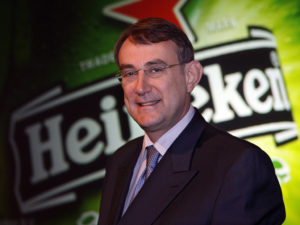 Heineken CEO Jean-Francois van Boxmeer told a crowd at the Cannes Lion that marketers of alcoholic beverages need to do more to encourage customers not to consume their products excessively.
Heineken CEO Jean-Francois van Boxmeer told a crowd at the Cannes Lion that marketers of alcoholic beverages need to do more to encourage customers not to consume their products excessively.
Van Boxmeer spoke at Cannes during a session hosted by Publicis Groupe CEO Maurice Levy. Also participating was Heineken CMO Alexis Nasard.
“Abuse is not cool at all,” van Boxmeer declared. A major challenge, he said, is getting brands to deliver a “credible message,” particularly to Millennials.
He said the industry has made “great progress” since Belgian brewers came up with the “don’t drink and drive” responsibility positioning about 20 years ago. But “we have more work to do,” in developing effective anti-abuse messages via advertising and websites.
“Brands have to tell it,” said van Boxmeer, “because people don’t buy a company.”
At the same session, Heineken CMO Alexis Nasard described creativity as a “decision. It sounds basic, but [as a client] you decide you want it and then ask for it.”
Creativity in marketing and advertising is “risky,” Nasard asserted. “Companies are not wired for risk. They’re wired for control.”
A healthy relationship between a client and an agency is a process where “sometimes we agree and sometimes we’re furious at each other,” Nasard said. A client ought to have a personal relationship with agency creatives. “If they shun you, you’re not in a good place,” he said. Indeed, he said they should always be just a “phone call away,” because many big ideas spring from “spontaneous conversations.”
Marketers shouldn’t just hand off the creative effort to their roster shops, Nasard said. “It’s important to have a creative team inside” the client company that works closely with agencies.
As to the growing complexity of the media landscape, Nasard stressed that it is important to understand that consumers aren’t abandoning traditional media as they spend greater amounts of time on digital platforms. “The separation is totally artificial,” he said. “They’re just consuming more of it.”
The landscape is getting more complicated, but Nasard said it’s essential to realize that the 30-second spot “is not dead and will not die.” It will continue to migrate to platforms outside of the TV box, he added, because it is “the most effective and ultimate format of communication. It reaches all the senses.”

You must be logged in to post a comment Login